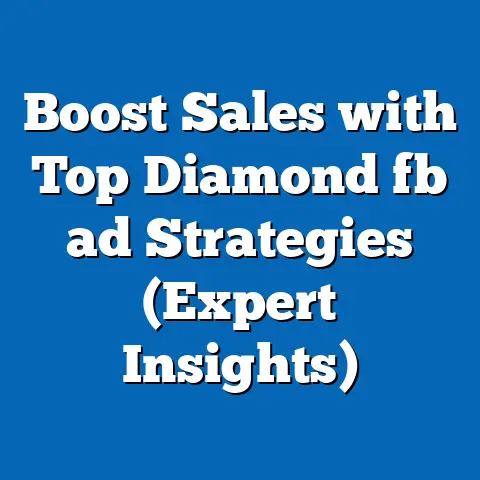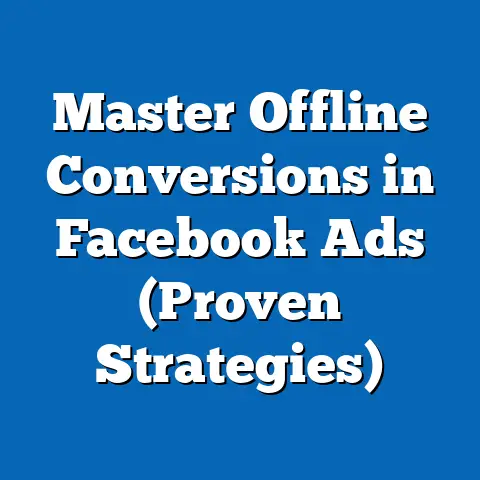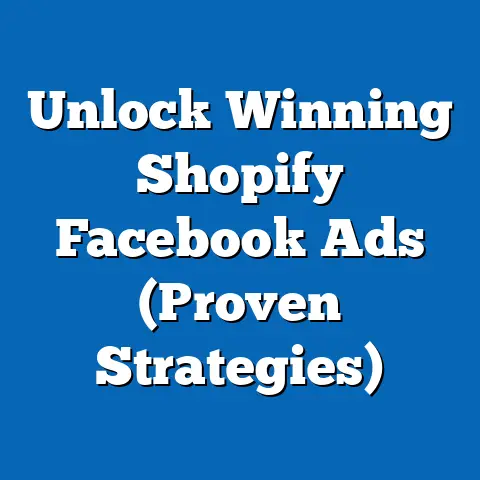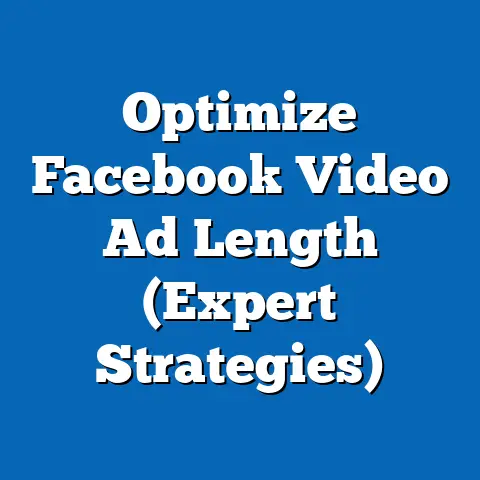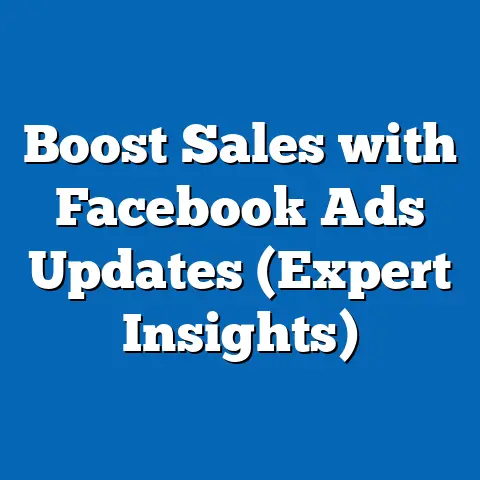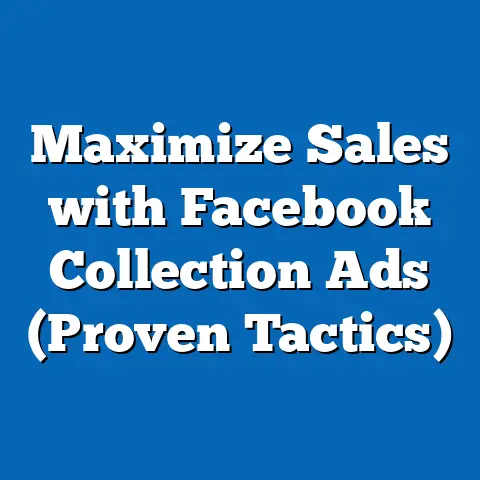Unlocking Optimal Facebook Ad Length (Expert Insights)
I remember the day I launched my first Facebook ad campaign like it was yesterday. I was brimming with excitement, convinced I had the perfect product and the wittiest copy. I poured my heart and soul into crafting what I thought was a masterpiece, a lengthy, detailed ad that explained every single benefit of my offering. I hit ‘publish’ and waited for the sales to roll in. Crickets. Utter silence.
Days turned into weeks, and my meticulously crafted ad was generating little more than a handful of likes and a whole lot of wasted ad spend. Frustrated and confused, I started digging into the data, scouring forums, and devouring any article I could find on Facebook advertising. That’s when it hit me: my ad was too long. Way too long. People scrolling through their feeds weren’t going to stop and read a novel about my product. They wanted something quick, engaging, and immediately relevant.
The Importance of Ad Length
In the fast-paced world of social media, attention is a precious commodity. People are bombarded with information, scrolling endlessly through their feeds, and only the most captivating content manages to grab their attention. That’s where ad length comes into play. The length of your Facebook ad can be the difference between a scroll-stopping success and a forgettable flop.
Why does ad length matter so much? It boils down to a few key factors:
-
Attention Span: Studies show that the average human attention span is shrinking, now estimated to be even shorter than that of a goldfish. This means you have only a few seconds to capture someone’s interest and convince them to engage with your ad. Long, rambling ads simply won’t cut it.
-
Mobile Viewing: The vast majority of Facebook users access the platform on their mobile devices. This means your ads are being viewed on smaller screens, where long blocks of text can appear overwhelming and unappealing.
-
Algorithm Prioritization: Facebook’s algorithm prioritizes ads that are engaging and relevant to users. Ads that are quickly scrolled past or ignored are less likely to be shown to a wider audience, impacting your reach and overall campaign performance.
Attention Span: Studies show that the average human attention span is shrinking, now estimated to be even shorter than that of a goldfish. This means you have only a few seconds to capture someone’s interest and convince them to engage with your ad. Long, rambling ads simply won’t cut it.
Mobile Viewing: The vast majority of Facebook users access the platform on their mobile devices. This means your ads are being viewed on smaller screens, where long blocks of text can appear overwhelming and unappealing.
Algorithm Prioritization: Facebook’s algorithm prioritizes ads that are engaging and relevant to users. Ads that are quickly scrolled past or ignored are less likely to be shown to a wider audience, impacting your reach and overall campaign performance.
Think of it this way: your ad is competing with adorable puppies, hilarious memes, and updates from friends and family. To stand out from the crowd, you need to deliver your message quickly, clearly, and compellingly.
According to a study by HubSpot, shorter Facebook ad copy tends to perform better. They found that ads with around 50 characters or less had higher engagement rates. While this isn’t a hard and fast rule, it highlights the importance of conciseness.
Expert Insight: Neil Patel, a renowned digital marketing expert, emphasizes the importance of testing different ad lengths to see what resonates best with your target audience. He suggests experimenting with both short, punchy ads and longer, more detailed ads to determine which format drives the best results for your specific business.
Takeaway: Ad length is a critical factor in Facebook advertising success. It directly impacts user engagement, algorithm prioritization, and overall campaign performance. Keep your ads concise, relevant, and visually appealing to capture attention and drive results.
The Psychology of Readability
Understanding the psychology of readability is crucial for crafting effective Facebook ads. It’s not just about the number of characters; it’s about how your message is perceived and processed by the human brain. Several psychological factors come into play when users read and engage with ads:
-
Cognitive Load: Cognitive load refers to the mental effort required to process information. If your ad is too long or complex, it can overwhelm the reader and increase their cognitive load, making them less likely to engage.
-
Information Overload: In today’s digital age, people are constantly bombarded with information. This can lead to information overload, where they become overwhelmed and tune out anything that requires too much mental effort.
-
Visual Hierarchy: The way your ad is visually structured can significantly impact readability. Using headings, subheadings, bullet points, and white space can make your ad easier to scan and digest.
-
Emotional Connection: Ads that evoke an emotional response are more likely to be remembered and acted upon. However, you need to strike a balance between emotional appeal and clarity.
Cognitive Load: Cognitive load refers to the mental effort required to process information. If your ad is too long or complex, it can overwhelm the reader and increase their cognitive load, making them less likely to engage.
Information Overload: In today’s digital age, people are constantly bombarded with information. This can lead to information overload, where they become overwhelmed and tune out anything that requires too much mental effort.
Visual Hierarchy: The way your ad is visually structured can significantly impact readability. Using headings, subheadings, bullet points, and white space can make your ad easier to scan and digest.
Emotional Connection: Ads that evoke an emotional response are more likely to be remembered and acted upon. However, you need to strike a balance between emotional appeal and clarity.
Expert Insight: Dr. Susan Weinschenk, a behavioral psychologist and author of “100 Things Every Designer Needs to Know About People,” emphasizes the importance of understanding how people read online. She suggests using clear and concise language, breaking up text into smaller chunks, and using visuals to enhance comprehension.
Demographic Differences: It’s also important to consider your target audience when determining the optimal ad length. Younger audiences, accustomed to consuming information in short bursts, may prefer shorter, snappier ads. Older demographics, on the other hand, may appreciate more detailed information and a more formal tone.
Example: Let’s say you’re advertising a new fitness app. A shorter ad targeting younger audiences might focus on the convenience and fun aspects of the app, using phrases like “Get fit fast!” or “Workout anywhere, anytime!” A longer ad targeting older demographics might focus on the health benefits and scientific backing of the app, using phrases like “Improve your cardiovascular health” or “Scientifically proven to boost energy levels.”
Takeaway: Consider the psychological factors that affect readability when crafting your Facebook ads. Keep your message concise, visually appealing, and emotionally engaging to capture attention and drive results. Remember to tailor your ad length and tone to your specific target audience.
Testing Ad Length: A Case Study
One of the most valuable lessons I learned about Facebook advertising came from a personal case study involving a campaign for a local bakery. The bakery wanted to promote its new line of artisanal breads and pastries to a wider audience. I was tasked with creating a Facebook ad campaign to drive traffic to their website and increase online orders.
Initially, I created a single ad with a fairly lengthy description, highlighting the bakery’s commitment to using high-quality ingredients, its traditional baking methods, and the unique flavors of its products. The ad performed reasonably well, generating a decent number of clicks and impressions. However, the conversion rate (the percentage of people who clicked on the ad and actually placed an order) was lower than expected.
I suspected that the ad length might be a factor, so I decided to conduct a split test. I created two variations of the ad:
-
Ad A (Long): This ad contained a detailed description of the bakery’s products, its history, and its commitment to quality. It was approximately 150 characters long.
-
Ad B (Short): This ad contained a concise message highlighting the bakery’s new line of artisanal breads and pastries, with a call to action to visit the website. It was approximately 50 characters long.
Ad A (Long): This ad contained a detailed description of the bakery’s products, its history, and its commitment to quality. It was approximately 150 characters long.
Ad B (Short): This ad contained a concise message highlighting the bakery’s new line of artisanal breads and pastries, with a call to action to visit the website. It was approximately 50 characters long.
I ran the two ads simultaneously, targeting the same audience and using the same budget. After a week of testing, the results were clear:
-
Ad A (Long): Click-through rate (CTR) of 0.5%, conversion rate of 1%.
-
Ad B (Short): Click-through rate (CTR) of 1.2%, conversion rate of 2.5%.
Ad A (Long): Click-through rate (CTR) of 0.5%, conversion rate of 1%.
Ad B (Short): Click-through rate (CTR) of 1.2%, conversion rate of 2.5%.
The shorter ad significantly outperformed the longer ad in both CTR and conversion rate. This confirmed my suspicion that ad length was a critical factor in the campaign’s success.
Lessons Learned:
-
Conciseness is Key: The shorter ad was more effective because it delivered a clear and concise message that resonated with the target audience.
-
Mobile Optimization: The shorter ad was also better optimized for mobile viewing, as it was easier to read and digest on smaller screens.
-
Call to Action: The shorter ad included a strong call to action that encouraged users to visit the website and place an order.
Conciseness is Key: The shorter ad was more effective because it delivered a clear and concise message that resonated with the target audience.
Mobile Optimization: The shorter ad was also better optimized for mobile viewing, as it was easier to read and digest on smaller screens.
Call to Action: The shorter ad included a strong call to action that encouraged users to visit the website and place an order.
Implications for Future Campaigns:
Based on the results of this case study, I made several changes to my Facebook advertising strategy:
- I started prioritizing shorter, more concise ad copy.
- I focused on highlighting the key benefits of the product or service being advertised.
- I included a strong call to action in every ad.
- I continuously tested different ad lengths to optimize performance.
Takeaway: This case study demonstrates the importance of testing different ad lengths to determine what works best for your specific business and target audience. Don’t be afraid to experiment and iterate based on the data you collect. Remember, what works for one business may not work for another.
Expert Opinions on Optimal Ad Length
While there’s no one-size-fits-all answer to the question of optimal Facebook ad length, gathering insights from industry experts can provide valuable guidance. Here’s a compilation of expert opinions on the topic:
-
Mari Smith (Social Media Expert): Mari Smith recommends keeping Facebook ad copy concise and focused on the key benefits. She suggests using short, punchy sentences and avoiding jargon or technical terms. She often advocates for ads under 90 characters for maximum impact.
-
Jon Loomer (Facebook Ads Expert): Jon Loomer emphasizes the importance of testing different ad lengths to see what resonates best with your target audience. He suggests experimenting with both short, attention-grabbing headlines and longer, more detailed descriptions. He also recommends paying close attention to the mobile preview to ensure your ad looks good on smaller screens.
-
Amy Porterfield (Online Marketing Expert): Amy Porterfield suggests focusing on creating a compelling offer that captures attention and drives conversions. She recommends using a clear and concise call to action that tells people exactly what you want them to do. She also stresses the importance of using high-quality visuals that complement your ad copy.
-
Buffer (Social Media Management Platform): Buffer’s research suggests that shorter Facebook posts tend to perform better than longer posts. They found that posts with around 80 characters or less had higher engagement rates. However, they also caution that this is just a general guideline and that the optimal length may vary depending on your specific audience and content.
Mari Smith (Social Media Expert): Mari Smith recommends keeping Facebook ad copy concise and focused on the key benefits. She suggests using short, punchy sentences and avoiding jargon or technical terms. She often advocates for ads under 90 characters for maximum impact.
Jon Loomer (Facebook Ads Expert): Jon Loomer emphasizes the importance of testing different ad lengths to see what resonates best with your target audience. He suggests experimenting with both short, attention-grabbing headlines and longer, more detailed descriptions. He also recommends paying close attention to the mobile preview to ensure your ad looks good on smaller screens.
Amy Porterfield (Online Marketing Expert): Amy Porterfield suggests focusing on creating a compelling offer that captures attention and drives conversions. She recommends using a clear and concise call to action that tells people exactly what you want them to do. She also stresses the importance of using high-quality visuals that complement your ad copy.
Buffer (Social Media Management Platform): Buffer’s research suggests that shorter Facebook posts tend to perform better than longer posts. They found that posts with around 80 characters or less had higher engagement rates. However, they also caution that this is just a general guideline and that the optimal length may vary depending on your specific audience and content.
Mini-Guide: Expert Recommendations Based on Ad Type:
| Ad Type | Expert Recommendation |
|---|---|
| Image Ads | Keep the headline short and attention-grabbing (under 25 characters). Use a concise description (under 90 characters). |
| Video Ads | Focus on the first few seconds of the video to capture attention. Use a short and compelling description (under 90 characters). |
| Carousel Ads | Use concise headlines and descriptions for each card in the carousel (under 25 characters for headlines, under 90 for descriptions). |
| Collection Ads | Use high-quality visuals and a short, compelling headline (under 25 characters). |
| Lead Generation Ads | Keep the form short and easy to fill out. Use a clear and concise description of the offer (under 90 characters). |
| Ad Type | Expert Recommendation |
|---|---|
| Image Ads | Keep the headline short and attention-grabbing (under 25 characters). Use a concise description (under 90 characters). |
| Video Ads | Focus on the first few seconds of the video to capture attention. Use a short and compelling description (under 90 characters). |
| Carousel Ads | Use concise headlines and descriptions for each card in the carousel (under 25 characters for headlines, under 90 for descriptions). |
| Collection Ads | Use high-quality visuals and a short, compelling headline (under 25 characters). |
| Lead Generation Ads | Keep the form short and easy to fill out. Use a clear and concise description of the offer (under 90 characters). |
Takeaway: While expert opinions vary, the general consensus is that shorter Facebook ads tend to perform better than longer ads. Focus on delivering a clear and concise message, highlighting the key benefits, and including a strong call to action. Continuously test different ad lengths and formats to optimize performance for your specific business and target audience.
Crafting the Perfect Facebook Ad: Length vs. Content
Finding the perfect balance between ad length and content quality is a delicate art. It’s not enough to simply write a short ad; you need to ensure that your message is compelling, informative, and relevant to your target audience. Here are some tips for crafting the perfect Facebook ad:
-
Prioritize Key Messages: Identify the most important information you want to convey and focus on delivering those messages concisely. Cut out any unnecessary words or phrases.
-
Use Strong Verbs and Adjectives: Choose words that are impactful and engaging. Use strong verbs to create a sense of urgency and excitement. Use descriptive adjectives to paint a vivid picture in the reader’s mind.
-
Focus on Benefits, Not Features: Instead of listing the features of your product or service, focus on the benefits it provides to the customer. How will it make their life easier, better, or more enjoyable?
-
Tell a Story: Even in a short ad, you can still tell a compelling story. Use a relatable anecdote or a customer testimonial to connect with your audience on an emotional level.
-
Use Visuals Effectively: High-quality visuals can significantly enhance the impact of your ad. Choose images or videos that are relevant to your message and that capture attention.
Prioritize Key Messages: Identify the most important information you want to convey and focus on delivering those messages concisely. Cut out any unnecessary words or phrases.
Use Strong Verbs and Adjectives: Choose words that are impactful and engaging. Use strong verbs to create a sense of urgency and excitement. Use descriptive adjectives to paint a vivid picture in the reader’s mind.
Focus on Benefits, Not Features: Instead of listing the features of your product or service, focus on the benefits it provides to the customer. How will it make their life easier, better, or more enjoyable?
Tell a Story: Even in a short ad, you can still tell a compelling story. Use a relatable anecdote or a customer testimonial to connect with your audience on an emotional level.
Use Visuals Effectively: High-quality visuals can significantly enhance the impact of your ad. Choose images or videos that are relevant to your message and that capture attention.
Examples of Successful Ads with Effective Use of Length:
-
Dollar Shave Club: Dollar Shave Club is known for its witty and humorous ads. Their Facebook ads are often short and to the point, focusing on the value proposition of their subscription service.
-
Airbnb: Airbnb uses high-quality photos of unique properties to capture attention and inspire wanderlust. Their ad copy is often short and sweet, highlighting the key features of the property and encouraging users to book their next vacation.
-
Nike: Nike’s Facebook ads are often inspirational and motivational, focusing on the power of sports and the human spirit. Their ad copy is often concise and impactful, using powerful imagery and emotional language.
Dollar Shave Club: Dollar Shave Club is known for its witty and humorous ads. Their Facebook ads are often short and to the point, focusing on the value proposition of their subscription service.
Airbnb: Airbnb uses high-quality photos of unique properties to capture attention and inspire wanderlust. Their ad copy is often short and sweet, highlighting the key features of the property and encouraging users to book their next vacation.
Nike: Nike’s Facebook ads are often inspirational and motivational, focusing on the power of sports and the human spirit. Their ad copy is often concise and impactful, using powerful imagery and emotional language.
Insights on Prioritizing Key Messages:
When crafting your Facebook ad, ask yourself these questions:
- What is the single most important thing I want people to know about my product or service?
- What problem does my product or service solve?
- What are the key benefits of using my product or service?
- What is the one thing I want people to do after seeing my ad?
Once you have answered these questions, you can use the answers to prioritize your key messages and craft a concise and compelling ad.
Takeaway: Crafting the perfect Facebook ad is about finding the right balance between length and content. Focus on delivering a clear and concise message, highlighting the key benefits, and including a strong call to action. Use visuals effectively and prioritize your key messages to capture attention and drive results.
The Evolution of Facebook Ad Length Guidelines
Facebook’s advertising guidelines have evolved significantly over the years, reflecting changes in user behavior, platform updates, and industry best practices. Understanding this evolution can provide valuable insights into the current state of Facebook advertising and help you anticipate future trends.
-
Early Days (2004-2010): In the early days of Facebook advertising, there were fewer restrictions on ad length. Advertisers had more freedom to write longer, more detailed ads. However, user engagement was often low, as people were not yet accustomed to seeing ads in their social feeds.
-
The Rise of Mobile (2010-2015): As mobile usage increased, Facebook began to prioritize shorter, more concise ads that were better optimized for smaller screens. They introduced stricter character limits for headlines, descriptions, and link descriptions.
-
Algorithm Updates (2015-Present): Facebook’s algorithm has become increasingly sophisticated over the years, prioritizing ads that are engaging and relevant to users. This has led to a renewed emphasis on ad quality, including ad length.
Early Days (2004-2010): In the early days of Facebook advertising, there were fewer restrictions on ad length. Advertisers had more freedom to write longer, more detailed ads. However, user engagement was often low, as people were not yet accustomed to seeing ads in their social feeds.
The Rise of Mobile (2010-2015): As mobile usage increased, Facebook began to prioritize shorter, more concise ads that were better optimized for smaller screens. They introduced stricter character limits for headlines, descriptions, and link descriptions.
Algorithm Updates (2015-Present): Facebook’s algorithm has become increasingly sophisticated over the years, prioritizing ads that are engaging and relevant to users. This has led to a renewed emphasis on ad quality, including ad length.
Historical Changes in Facebook’s Advertising Guidelines:
- 2010: Facebook introduced character limits for headlines and descriptions in news feed ads.
- 2013: Facebook updated its ad specs to provide more guidance on optimal image sizes and text lengths.
- 2016: Facebook launched Canvas ads, a mobile-optimized ad format that allows for longer, more immersive experiences.
- 2018: Facebook updated its algorithm to prioritize ads that are relevant and engaging to users, regardless of length.
- 2020: Facebook continued to refine its ad specs and provide more guidance on optimal ad length for different ad formats.
Shifts in User Behavior and Platform Updates:
- Shorter Attention Spans: As mentioned earlier, the average human attention span is shrinking, making it more important than ever to capture attention quickly.
- Mobile Dominance: Mobile devices are now the primary way people access Facebook, making mobile optimization a critical factor in ad success.
- Algorithm Complexity: Facebook’s algorithm is constantly evolving, making it more challenging for advertisers to reach their target audience.
Predictions for Future Trends:
- Increased Personalization: Facebook is likely to continue to invest in personalization, delivering ads that are highly relevant to individual users.
- More Visual Content: Visual content is likely to become even more important in the future, as people are increasingly drawn to images and videos.
- AI-Powered Advertising: Artificial intelligence is likely to play a bigger role in Facebook advertising, helping advertisers optimize their campaigns and reach their target audience more effectively.
Comparisons to Other Social Media Platforms:
- Twitter: Twitter is known for its strict character limits, forcing advertisers to be extremely concise.
- Instagram: Instagram relies heavily on visual content, with less emphasis on ad copy.
- LinkedIn: LinkedIn is more focused on professional content, with longer, more detailed ads being common.
Takeaway: Facebook’s advertising guidelines have evolved significantly over the years, reflecting changes in user behavior, platform updates, and industry best practices. Stay up-to-date on the latest guidelines and trends to ensure that your ads are optimized for success.
Key Takeaways:
- Ad length matters: It directly impacts user engagement, algorithm prioritization, and overall campaign performance.
- Conciseness is key: Shorter ads tend to perform better, but the content must be compelling and relevant.
- Test, test, test: Experiment with different ad lengths to see what resonates best with your specific audience.
- Stay updated: Facebook’s advertising guidelines and user behavior are constantly evolving, so stay informed.
Looking Ahead:
The future of Facebook advertising is likely to be even more personalized, visual, and AI-powered. Advertisers will need to adapt their strategies to keep pace with these changes. Here are some predictions for the future of Facebook ad length:
- Even shorter ads: As attention spans continue to shrink, advertisers may need to create even shorter, more concise ads to capture attention.
- More visual storytelling: Visuals will become even more important, with advertisers using images and videos to tell compelling stories in a short amount of time.
- AI-powered ad optimization: AI will help advertisers optimize their ad length and content for maximum impact.
Call to Action:
Now that you have a comprehensive understanding of Facebook ad length, it’s time to put your knowledge into practice. Experiment with different ad lengths, test your results, and continuously optimize your campaigns. Don’t be afraid to try new things and push the boundaries of what’s possible. The future of Facebook advertising is in your hands.
Final Thoughts:
Remember that Facebook advertising is a marathon, not a sprint. It takes time, effort, and continuous learning to achieve success. Stay persistent, stay curious, and never stop experimenting. With the right knowledge and the right approach, you can unlock the power of Facebook advertising and achieve your business goals. Good luck!

